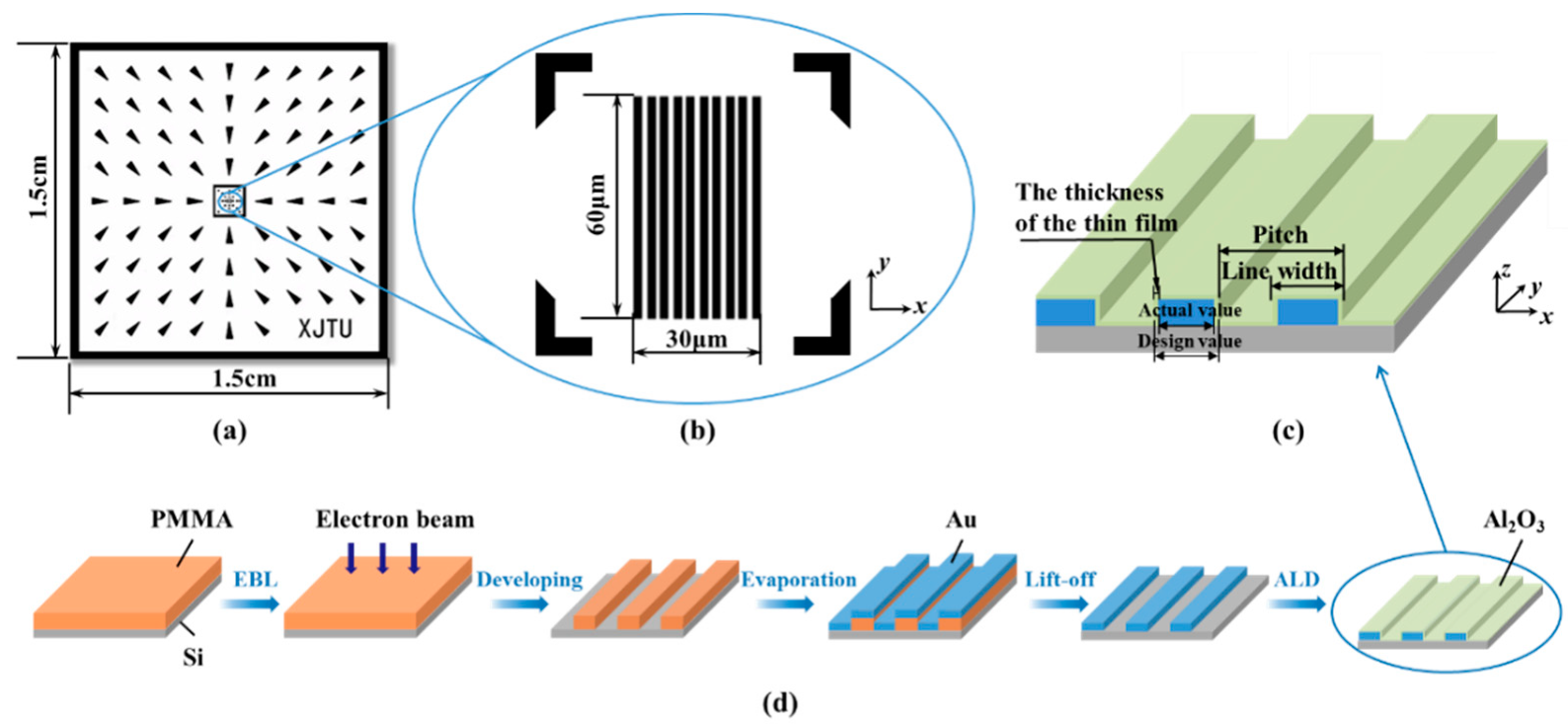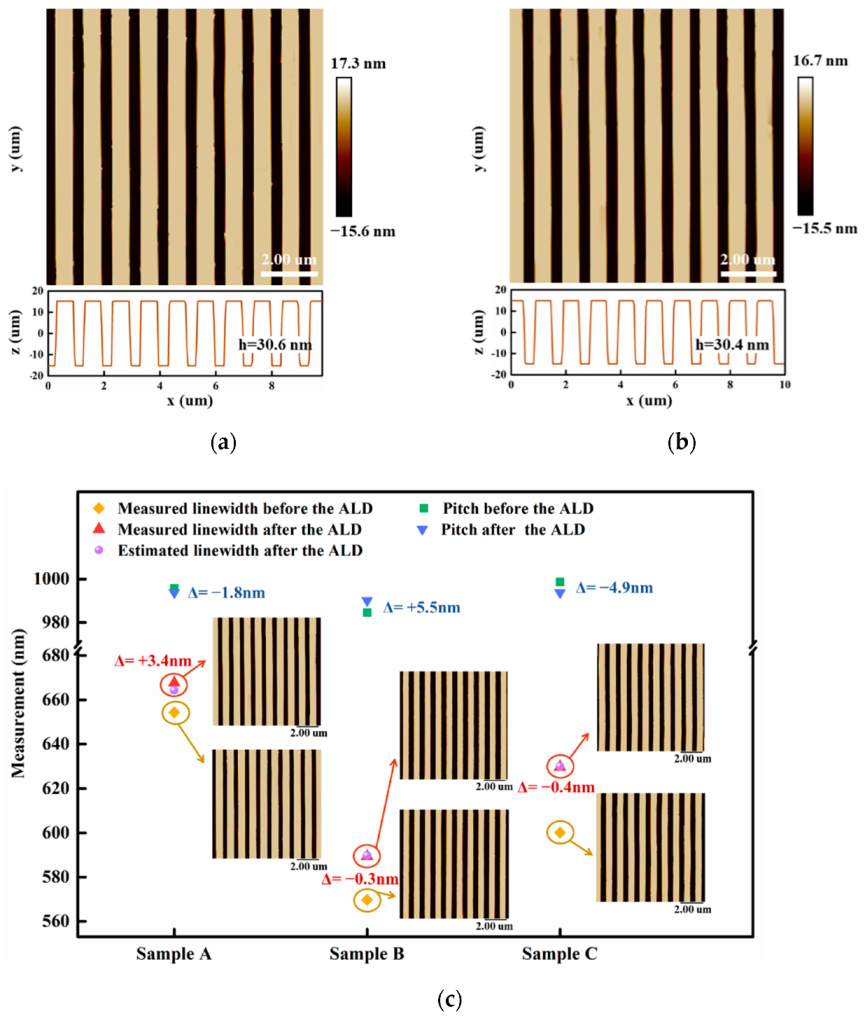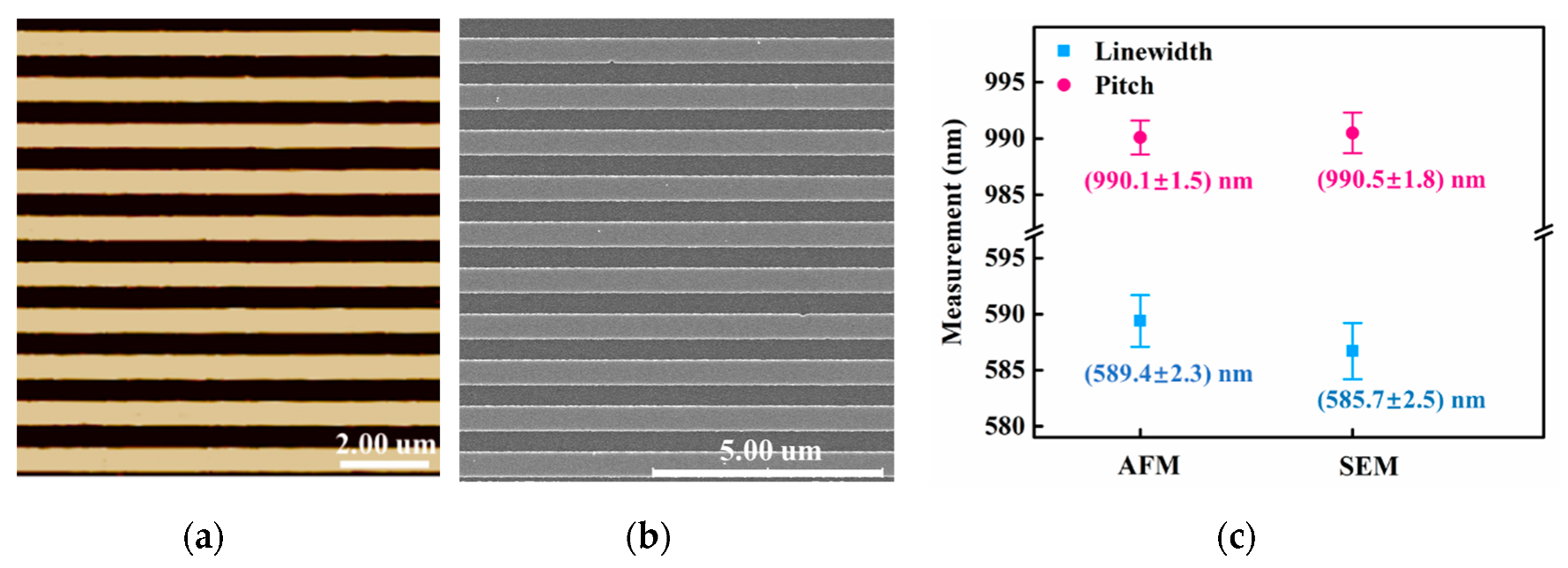High-Precision Regulation of Nano-Grating Linewidth Based on ALD
Abstract
1. Introduction
2. Design and Fabrication
2.1. Structural Design
2.2. Materials and Fabrication
2.3. Measuremnt
3. Results and Discussion
3.1. Results of Regulation
3.2. Application
4. Conclusions
Author Contributions
Funding
Conflicts of Interest
References
- Xu, L.; Yang, J.; Qiu, C.; Liu, S.; Zhou, W.; Li, Q.; Shi, B.; Ma, J.; Yang, C.; Lu, J.; et al. Can Carbon Nanotube Transistors Be Scaled Down to the Sub-5 nm Gate Length? ACS Appl. Mater. Interfaces 2021, 13, 31957–31967. [Google Scholar] [CrossRef] [PubMed]
- Loubet, N.; Hook, T.; Montanini, P.; Yeung, C.W.; Kanakasabapathy, S.; Guillom, M.; Yamashita, T.; Zhang, J.; Miao, X.; Wang, J.; et al. Stacked nanosheet gate-all-around transistor to enable scaling beyond FinFET. In Proceedings of the 2017 Symposium on VLSI Technology, Kyoto, Japan, 5–8 June 2017; IEEE: Piscataway, NJ, USA, 2017; pp. T230–T231. [Google Scholar]
- Wu, F.; Tian, H.; Shen, Y.; Hou, Z.; Ren, J.; Gou, G.; Sun, Y.; Yang, Y.; Ren, T.L. Vertical MoS2 transistors with sub-1-nm gate lengths. Nature 2022, 603, 259–264. [Google Scholar] [CrossRef] [PubMed]
- Hills, G.; Lau, C.; Wright, A.; Fuller, S.; Bishop, M.D.; Srimani, T.; Kanhaiya, P.; Ho, R.; Amer, A.; Stein, Y.; et al. Modern microprocessor built from complementary carbon nanotube transistors. Nature 2019, 572, 595–602. [Google Scholar] [CrossRef] [PubMed]
- Qiu, C.; Zhang, Z.; Xiao, M.; Yang, Y.; Zhong, D.; Peng, L.M. Scaling carbon nanotube complementary transistors to 5-nm gate lengths. Science 2017, 355, 271–276. [Google Scholar] [CrossRef]
- Dixson, R.G.; Chernoff, D.A.; Wang, S.; Vorburger, T.V.; Tan, S.L.; Orji, N.G.; Fu, J. Multilaboratory comparison of traceable atomic force microscope measurements of a 70-nm grating pitch standard. J. Micro-Nanolithogr. MEMS MOEMS 2011, 10, 013015. [Google Scholar]
- Vladár, A.E.; Postek, M.T. Reference Material (RM) 8820: A New Scanning Electron Microscope Scale Calibration Artifact. Microsc. Microanal. 2009, 15, 668–669. [Google Scholar] [CrossRef][Green Version]
- Raid, I.; Eifler, M.; Kusnezowa, T.; Seewig, J. Calibration of Ellipso-Height-Topometry with Nanoscale Gratings of Varying Materials. Opt.-Int. J. Light Electron. Opt. 2015, 126, 4591–4596. [Google Scholar] [CrossRef]
- Misumi, I.; Kitta, J.I.; Fujimoto, H.; Gonda, S.; Azuma, Y.; Maeda, K.; Kurosawa, T.; Ito, Y.; Omote, K.; Nakayama, Y.; et al. 25 nm pitch comparison between a traceable x-ray diffractometer and a metrological atomic force microscope. Meas. Sci. Technol. 2012, 23, 136. [Google Scholar] [CrossRef]
- Nakayama, Y.; Yamamoto, J.; Kawada, H. Critical dimension-scanning electron microscope magnification calibration with 25-nm pitch grating reference. J. Micro/Nanolithogr. MEMS MOEMS 2011, 10, 013021. [Google Scholar] [CrossRef]
- Deng, X.; Dai, G.; Liu, J.; Hu, X.; Bergmann, D.; Zhao, J.; Tai, R.; Cai, X.; Li, Y.; Li, T.; et al. A new type of nanoscale reference grating manufactured by combined laser-focused atomic deposition and X-ray interference lithography and its use for calibrating a scanning electron microscope. Ultramicroscopy 2021, 226, 113293. [Google Scholar] [CrossRef]
- Deng, X.; Liu, J.; Zhu, L.; He, P.; Cheng, X.; Li, T. Natural square ruler at nanoscale. Appl. Phys. Express 2018, 11, 075201. [Google Scholar] [CrossRef]
- VLSI Standards Incorporated, Nanolattice Pitch Standard (NLSM). Available online: https://www.vlsistandards.com/products/dimensional/lattice_info.asp?SID=78,2022 (accessed on 27 April 2022).
- Feng, B.; Chen, Y.; Sun, D.; Yang, Z.; Yang, B.; Li, X.; Li, T. Precision integration of grating-based polarizers onto focal plane arrays of near-infrared photovoltaic detectors for enhanced contrast polarimetric imaging. Int. J. Extrem. Manuf. 2021, 3, 035201. [Google Scholar] [CrossRef]
- Dai, G.; Zhu, F.; Heidelmann, M.; Fritz, G.; Bayer, T.; Kalt, S.; Fluegge, J. Development and characterisation of a new linewidth reference material. Meas. Sci. Technol. 2015, 26, 115006. [Google Scholar] [CrossRef]
- Huebner, U.; Morgenroth, W.; Boucher, R.; Meyer, M.; Mirandé, W.; Buhr, E.; Ehret, G.; Dai, G.; Dziomba, T.; Hild, R.; et al. A nanoscale linewidth/pitch standard for high-resolution optical microscopy and other microscopic techniques. Meas. Sci. Technol. 2007, 18, 422. [Google Scholar] [CrossRef][Green Version]
- Sloyan, K.; Melkonyan, H.; Apostoleris, H.; Dahlem, M.; Chiesa, M.; Al Ghaferi, A. A review of focused ion beam applications in optical fibers. Nanotechnology 2021, 32, 472004. [Google Scholar] [CrossRef] [PubMed]
- Diddens, C.; Linz, S.J. Continuum modeling of particle redeposition during ion-beam erosion. Eur. Phys. J. B 2015, 88, 397. [Google Scholar] [CrossRef]
- Mirmohammad, H.; Kingstedt, O.T. Theoretical considerations for transitioning the grid method technique to the microscale. Exp. Mech. 2021, 61, 753–770. [Google Scholar] [CrossRef]
- Philipsen, V.; Luong, K.V.; Opsomer, K.; Detavernier, C.; Hendrickx, E.; Erdmann, A.; Evanschitzky, P.; Van De Kruijs, R.W.; Heidarnia-Fathabad, Z.; Scholze, F.; et al. Novel EUV mask absorber evaluation in support of next-generation EUV imaging. In Photomask Technology 2018; SPIE: Bellingham, WA, USA, 2018; Volume 10810, pp. 53–65. [Google Scholar]
- Geng, G.; Zhu, W.; Pan, R.; Zhang, Z.; Gu, C.; Li, J. Precise tailoring of multiple nanostructures based on atomic layer assembly via versatile soft-templates. Nano Today 2021, 38, 101145. [Google Scholar] [CrossRef]
- Franklin, D.; George, M.; Fraser, J.; Chanda, D. Atomic layer deposition tuning of subwavelength aluminum grating for angle-insensitive plasmonic color. ACS Appl. Nano Mater. 2018, 1, 5210–5216. [Google Scholar] [CrossRef]
- Meng, X.; Comstock, D.J.; Fister, T.T.; Elam, J.W. Vapor-phase atomic-controllable growth of amorphous Li2S for high-performance lithium–sulfur batteries. ACS Nano 2014, 8, 10963–10972. [Google Scholar] [CrossRef]
- Lee, K.; Kim, H.; Kim, J.H.; Choi, D. Structural color and near-infrared tunability of ruthenium-coated anodic aluminum oxide by atomic layer deposition. Scr. Mater. 2020, 187, 125–129. [Google Scholar] [CrossRef]
- Tamm, A.; Tarre, A.; Kozlova, J.; Rähn, M.; Jõgiaas, T.; Kahro, T.; Link, J.; Stern, R. Atomic layer deposition of superparamagnetic ruthenium-doped iron oxide thin film. RSC Adv. 2021, 11, 7521–7526. [Google Scholar] [CrossRef] [PubMed]
- Wang, C.; Yang, S.; Jing, W.; Ren, W.; Lin, Q.; Zhang, Y.; Jiang, Z. Fabrication of nanoscale step height structure using atomic layer deposition combined with wet etching. Chin. J. Mech. Eng. 2016, 29, 91–97. [Google Scholar] [CrossRef]
- Dai, G.; Koenders, L.; Pohlenz, F.; Dziomba, T.; Danzebrink, H.U. Accurate and traceable calibration of one-dimensional gratings. Meas. Sci. Technol. 2005, 16, 1241–1249. [Google Scholar] [CrossRef]
- Tortonese, M.; Prochazka, J.; Konicek, P.; Schneir, J.; Smith, I.R. 100-nm-pitch standard characterization for metrology applications. In Metrology, Inspection, and Process Control for Microlithography XVI; SPIE: Bellingham, WA, USA, 2002; Volume 4689, pp. 558–564. [Google Scholar]
- BIPM; EC; IFCC; ISO; IUPAC; IUPAP; OIML. Guide to the Expression of Uncertainty in Measurement; International Organization for Standardization: Geneva, Switzerland, 1995. [Google Scholar]
- Wang, C.; Pu, J.; Li, L.; Jing, W.; Zhang, Y.; Zhang, Y.; Han, F.; Liu, M.; Ren, W.; Jiang, Z. Effect of the Different Substrates and the Film Thickness on the Surface Roughness of Step Structure. In Proceedings of the 2021 IEEE 16th International Conference on Nano/Micro Engineered and Molecular Systems (NEMS), Xiamen, China, 25–29 April 2021; IEEE: Piscataway, NJ, USA, 2021; pp. 47–50. [Google Scholar]
- Misumi, I.; Dai, G.; Lu, M.; Sato, O.; Sugawara, K.; Gonda, S.; Takatsuji, T.; Danzebrink, H.U.; Koenders, L. Bilateral comparison of 25 nm pitch nanometric lateral scales for metrological scanning probe microscopes. Meas. Sci. Technol. 2010, 21, 035105. [Google Scholar] [CrossRef]





| Sample | A | B | C | |||
|---|---|---|---|---|---|---|
| Before ALD | After ALD | Before ALD | After ALD | Before ALD | After ALD | |
| Average pitch (nm) | 995.6 | 993.8 | 984.6 | 990.1 | 998.7 | 993.8 |
| Expanded uncertainty (k 1 = 2) (nm) | 3.70 | 1.14 | 4.35 | 1.54 | 6.06 | 1.18 |
Publisher’s Note: MDPI stays neutral with regard to jurisdictional claims in published maps and institutional affiliations. |
© 2022 by the authors. Licensee MDPI, Basel, Switzerland. This article is an open access article distributed under the terms and conditions of the Creative Commons Attribution (CC BY) license (https://creativecommons.org/licenses/by/4.0/).
Share and Cite
Zhang, Y.; Wang, C.; Jing, W.; Wang, S.; Zhang, Y.; Zhang, L.; Zhang, Y.; Zhu, N.; Wang, Y.; Zhao, Y.; et al. High-Precision Regulation of Nano-Grating Linewidth Based on ALD. Micromachines 2022, 13, 995. https://doi.org/10.3390/mi13070995
Zhang Y, Wang C, Jing W, Wang S, Zhang Y, Zhang L, Zhang Y, Zhu N, Wang Y, Zhao Y, et al. High-Precision Regulation of Nano-Grating Linewidth Based on ALD. Micromachines. 2022; 13(7):995. https://doi.org/10.3390/mi13070995
Chicago/Turabian StyleZhang, Yaxin, Chenying Wang, Weixuan Jing, Song Wang, Yujing Zhang, Liangliang Zhang, Yijun Zhang, Nan Zhu, Yunxiang Wang, Yifan Zhao, and et al. 2022. "High-Precision Regulation of Nano-Grating Linewidth Based on ALD" Micromachines 13, no. 7: 995. https://doi.org/10.3390/mi13070995
APA StyleZhang, Y., Wang, C., Jing, W., Wang, S., Zhang, Y., Zhang, L., Zhang, Y., Zhu, N., Wang, Y., Zhao, Y., Lin, Q., & Jiang, Z. (2022). High-Precision Regulation of Nano-Grating Linewidth Based on ALD. Micromachines, 13(7), 995. https://doi.org/10.3390/mi13070995






